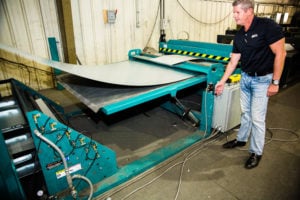You just moved into what you think will be the perfect building in a light-industrial area to grow your duct fabrication business. It’s got twice the space of your old facility, a large loading dock and parking for semitrailers. You’re set to quickly ramp up your shop’s duct production, right?
Maybe. Too often, sheet metal contractors get excited about the opportunities a new building offers without ensuring it’s laid out to maximize production and minimize the bottlenecks that can eat away at contractors’ profit margins.

Mike Bailey – Senior Vice President of Sales at Mestek Machinery
We asked Mike Bailey, Mestek Machinery’s vice president of sales and product development, to go over five commonly overlooked items that can trap sheet metal contractors when putting together their new shops.
Choosing a building location
The old real estate adage doesn’t just apply when buying a house or leasing office space. You might love the building that’s going to be your new sheet metal shop, but you need to make sure it works for your business.
The large tractor-trailers you’ll be using to transport duct to job sites need easy access to surface streets and freeways.
If you don’t take that into consideration, you may quickly make enemies of neighboring businesses for causing all sorts of “traffic and mayhem” every time you load a truck or receive a shipment, Bailey said.
“It could be problematic if you’re not in a good area,” he said. “I think that’s something (contractors and fabricators) may quickly forget.”
The solution? When site shopping, ensure your streets are designed to handle truck traffic and loading areas are set back far enough not to impact other businesses. Most importantly, there is a cost to transportation in general and the more efficient the better when it comes to loading and transporting.
Machinery placement
Sometimes, contractors and fabricators can become so excited by the prospect of a new coil line or other sheet metal machinery that they won’t think through the whole fabrication process. Bailey said these contractors end up with machinery “shoehorned” into a spot without thinking what the downstream processes to finalize production looks like.
Manufacturers such as Mestek can customize machinery to fit unusual spaces, but contractors have to think several steps ahead.
“After the duct comes off the machine, there’s got to be a place to work it up,” Bailey said. “You’ve got to have a knock-down area. And you’ve got to understand that knock-down area as it relates to shipping. Because as soon as it comes off the coil line, you’ve got to (put) it together and put it on the truck.”
The staging area needs to be close to the loading doors.
“You do not want to be dragging ducts across the floor some 50 feet away,” Bailey said. It’s not good for workers or the ductwork — or profits.
How you make use of the space
An empty building may seem like it has more room than your sheet metal shop will ever need when you’re considering purchasing or leasing the space. But you might be surprised, Bailey said.
“Space is always a consideration,” he said. “What most (people) don’t realize is how quickly this type of machinery can fill up a 20,000-square-foot area.”
And the key to successful shop layout is ensuring that machinery is spaced far enough apart that workers aren’t bumping into each other, but you don’t want them having to traverse a large shop floor to finish duct assembly tasks. It reduces efficiency and increases costs, Bailey said.
“Every step is a dollar,” he said.
Duct fittings assembly
Some contractors overlook the area where they’ll be attaching duct fittings. A lot of effort can be wasted if it’s not properly designed.
“You always want to be walking in a straight line,” Bailey said. “You don’t want to be circling machines.”
For example, some shops have one machine handling “male” and “female” fittings. That requires workers to circle a roll former and handle the duct twice. A better approach, Bailey said, is to have dedicated machines to make male and female seams. That way, you’ll only have to carry the duct once. It saves time.
Bailey said fittings production is the most costly area in every shop and should be well thought out to limit safety and cost liabilities.
“That’s what this industry is all about — trying to reduce labor and be more productive,” he added.
The approach to shop design
A well-designed sheet metal shop is clean, brightly lit, safe and designed to maximize efficiency, Bailey said. It can also produce more profits.
“The shop itself needs to be treated like an individual profit center,” he said. “It should be its own ‘machine.’ If I want to be profitable, I need to take best practices, I need to make it safe, well lit, (the) flow of material needs to be right. But you need to invest in the technology to do that.”

